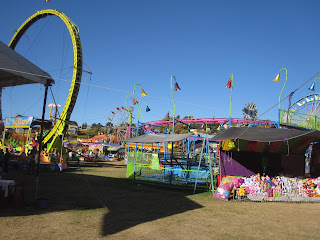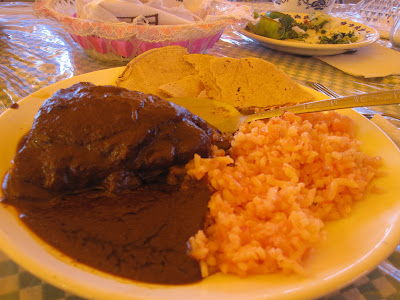This past Friday, we had quite an experience as we decided to make our way to the 35th Feria Nacional del Mole in San Pedro Atocpan in the southern, much less inhabited part of Mexico City (we refer to it now as our authentic pueblo experience). A subway ride to the last stop, a light rail trip to the last stop, an hour wandering to find the bus and a 30-minute crowded bus ride later, we arrived at the Feria....the wrong one, the so-called New Feria del Mole, at which we were the only, fairly disappointed patrons. Luckily, we asked, and the real one was right across the street, maybe 50 meters down the road (and with its giant ferris wheel, I don't know how we didn't see it). After we checked out the real festival, we hopped back on the bus for the long journey home. Except all of the roads back to Xochimilco bus station were inexplicably closed, and everyone got out of their buses to walk home on the highway weaving their way through the cars (think Independence Day/Cloverfield style mass exodus); of course, we joined them.
Authentic pueblo experience aside, the Mole Festival was incredible and exceeded everyone of my expectations once I got there. Of course, it had all the festival standards, like handicrafts, rides, games and a stage for traditional folk dancing, but also, as the name suggests, tons of mole! One side of the main festival boulevard was lined with stalls selling powders and pastes of the area's traditional almond mole, as well as other moles (like apple and pecan), pipians and even homemade peanut butter; the other side was filled with restaurants where all of these mole sauces and other traditional dishes were prepared. By the end of the boulevard, I had collected about 12 mini spoons that had once held delicious samples of various moles, PB, honey, sherbet and jams - all fresh and locally produced. Then, it was time to circle back and pick a place to eat. The culinary experiences (and taste-tests) were definitely worth the journey.
If you ever find yourself in Mexico City during the month of October, I highly recommend sucking up the journey and visiting this incredible fair, so here is some information (after the pic of the l'il horse) that might help you out, especially if you don't speak Spanish...
Feria Facts
www.ferianacionaldelmole.com.mx
When: Every October, nearly everyday (From what I can tell, it starts on the first weekend and ends on the Sunday of the fourth weekend.)
Where: San Pedro Atocpan, Milpa Alta
1) Rent a car or take a taxi and follow
the directions on the website (it's
only one highway, and the fair is
located on the highway).
or
2) Take the blue subway line to
Tasquena and transfer to the light
rail. Stay on the light rail to the end,
Xochimilco. Walk about 5 blocks
from the train station to the town's
center (walk in the direction of the
big church). Find bus 81, and take it
until you see a small misleading fair
on the left and a giant, obvious fair
further down on the right.
Cost: There is a very small admission fee of 5 pesos (40 cents) per person.










